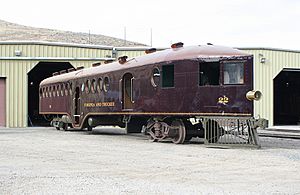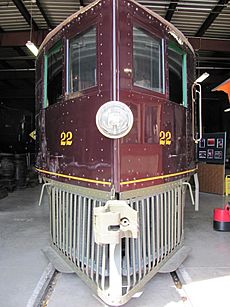Virginia and Truckee Railway Motor Car 22 facts for kids
Quick facts for kids Virginia and Truckee Railway Motor Car 22 |
|
 |
|
| Motor Car 22 after exterior restoration in 2009 | |
| Power type | Gasoline (1910), Diesel (2010) |
|---|---|
| Builder | McKeen Motor Car Company |
| Build date | 1909–1910 |
| AAR wheel arr. | A1-2 |
| Gauge | 4 ft 8 1⁄2 in (1,435 mm) |
| Driver diameter | 42 in (1,067 mm) |
| Wheel diameter | 33 in (838 mm) |
| Wheelbase | 52 ft 7 in (16.03 m) |
| Length | 72 ft 9+3⁄4 in (22.19 m) |
| Width | 10 ft 2+3⁄4 in (3.12 m) |
| Height | 11 ft 9+3⁄16 in (3.59 m) |
| Locomotive weight | 68,000 lb (30,844 kg) |
| Fuel capacity | 120 US gal (450 L) |
| Transmission | 1910: Morse chain drive 2010: Hydraulic drive |
| Power output | 200 hp (150 kW) |
| Delivered | May 9, 1910 |
| First run | June 2, 1910 |
| Retired | October 31, 1945 |
| Restored | 1997–May 9, 2010 |
| Current owner | Nevada State Railroad Museum |
| Official name: McKeen Motor Car #70 | |
| Designated: | September 6, 2005 |
| Reference #: | 05000968 |
| Designated: | October 16, 2012 |
The Virginia and Truckee Railway Motor Car 22, also known as McKeen Motor Car 70, is a special train car. It runs on gasoline and is now at the Nevada State Railroad Museum in Carson City, Nevada. The McKeen Motor Car Company built it for the Virginia and Truckee Railroad in 1910.
Motor Car 22 was used by the Virginia and Truckee until 1945. After that, it was sold and became a diner until 1955. Later, it was used as an office and storage for a plumbing business. In 1995, it was given to the Nevada State Railroad Museum. The Museum began restoring the car in 1997. The restored motor car was shown to the public in 2010. This was 100 years after it first arrived at the Virginia and Truckee. Motor Car 22 was added to the National Register of Historic Places in 2005. It was named a National Historic Landmark in 2012. It is one of only a few McKeen railcars left, and the only one that still works.
How Motor Car 22 Was Built
The Virginia and Truckee Railway Motor Car 22 is 72 feet 9+3⁄4 inches (22.19 m) long. It is 10 feet 2+3⁄4 inches (3.12 m) wide and 11 feet 9+3⁄16 inches (3.59 m) tall. It was one of the biggest railcars made by the McKeen Motor Car Company. The car's body sat on a chassis (frame) with two sets of wheels. Each set had two axles, and the wheels were 33-inch (838 mm) wide.
Motor Car 22 first used a 200-horsepower (150 kW) gasoline engine. This engine was like those used in boats. It connected to the car's 42 inches (1,067 mm) driving wheels using a special chain. During its restoration, the original engine was replaced. A modern Caterpillar diesel engine was used instead. This was because no original McKeen engines were available. The old chain drive was also changed to a hydraulic drive.
The car's body was made of steel. It had a special monocoque design, meaning the body itself was the main structure. It was shaped to be very aerodynamic, which means it could cut through the air easily. The car had a curved roof and a rounded back. Its front end was sharp, like a "wind-splitter." McKeen railcars were also known for their round porthole windows. Motor Car 22 had 33 of these windows.
Inside, Motor Car 22 had three main areas. The engine was in the pointed front part. The passengers sat in the back. In the middle was a space for baggage. When it was new, 84 passengers could sit inside.
History of Motor Car 22
In 1906, the Virginia and Truckee Railroad opened a new train line. It went from Carson City to Minden, Nevada. This line made money, so the railroad decided to add more passenger service. They chose to use self-propelled motor cars. These cars were cheaper to run than a full train pulled by a steam locomotive.
On October 6, 1909, the railroad ordered a 70-foot (20 m) railcar from the McKeen Motor Car Company. It cost $22,000. Motor Car 22 arrived on May 9, 1910. It started regular service on June 6, 1910.
By 1929, the railroad's profits were going down. They stopped using the McKeen car for a while. In 1932, it was changed into a railway post office. It also handled packages for the Railway Express Agency. After this, it went back into service. Motor Car 22 was retired on October 31, 1945. It had traveled 539,800 miles (868,700 km) and served for 35 years.
In 1946, the Virginia and Truckee sold the car's body. The engine and wheels were removed. The body was used as a diner in Carson City until 1955. Then, a plumbing business bought it. They used it as an office and for storage. In 1995, the remaining parts of Motor Car 22 were given to the Nevada State Railroad Museum.
Bringing it Back to Life: Restoration
From 1995 to August 1997, the Nevada State Railroad Museum studied Motor Car 22. They wanted to see if it could be restored to working condition. The study found that most of the original parts could be saved or copied. However, the original engine, transmission, and lighting system could not be found.
Motor Car 22 was added to the National Register of Historic Places on September 6, 2005. The study also found that only four McKeen motor cars still existed. Only two of these were the 70-foot (20 m) models, like Motor Car 22. None of the other cars were as well-preserved as Motor Car 22. One was changed into a passenger car in Anchorage, Alaska. Another was cut in half and used as a shed in Price, Utah. A third was turned into a diesel-electric switcher (a small train for moving cars).
The restoration of Motor Car 22 was officially finished on May 9, 2010. This was exactly 100 years after it was first delivered to the Virginia and Truckee. On October 16, 2012, the McKeen car was named a National Historic Landmark. The Nevada State Railroad Museum operates the car every year. You can see it run on Nevada Day, Independence Day, Father's Day, and National Train Day.


